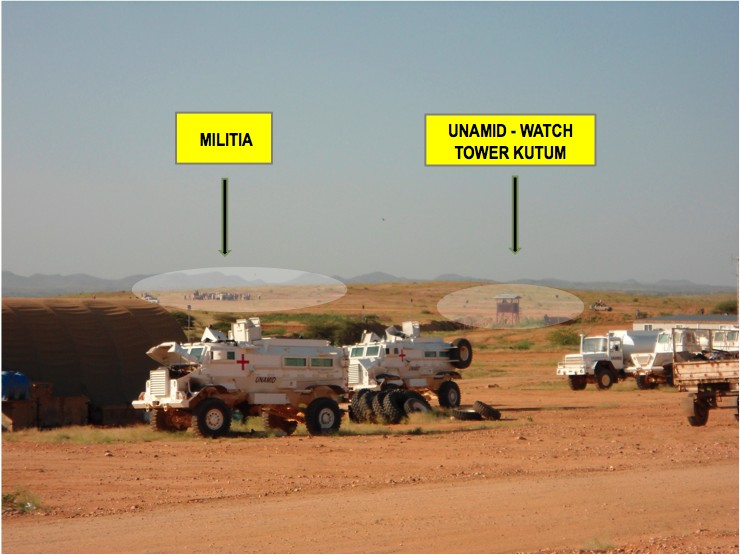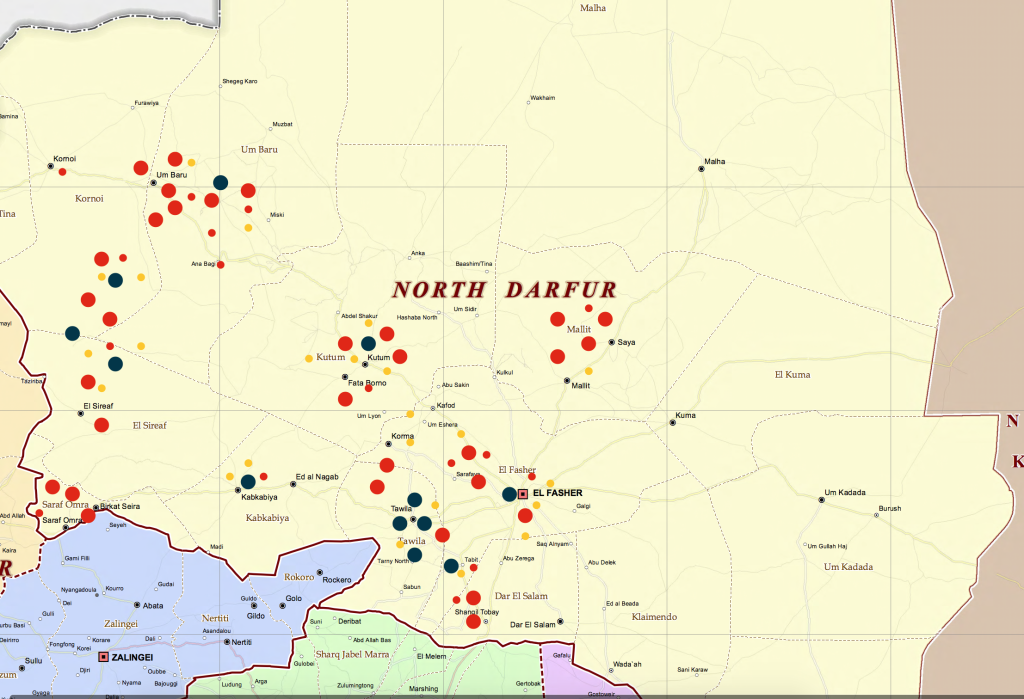Slashing UNAMID Translates Into Numerous Base Closings; Results Will Likely be Catastrophic in Some Areas
Eric Reeves | June 23, 2017 | http://wp.me/p45rOG-24x
Sources within the UN have released the list of UNAMID bases to be closed or stripped of a military (as opposed to a police) presence. The list makes painfully clear just how dangerously consequential are the Mission’s broad reductions: military presence in Darfur will be reduced by 44 percent and the police presence by 33 percent. There will also be a significant drawdown of non-armed UNAMID personnel, with inevitably hindering consequences for the operations of the remaining armed elements of UNAMID.
I will gloss the specific implications of the list below, but some are simply unconscionable and will put an end to humanitarian access. It should be noted that the UN’s Humanitarian Air Service (UNHAS) will not fly to locations that are without a military presence. This alone represents an extreme threat to humanitarian access in Darfur.
This list many not be fully comprehensive, and may be subject to slight modification. But given the end-of-June deadline for a UN Security Council resolution re-authorizing UNAMID in re-configured form, the list is almost certainly accurate to a very high degree:
CAMPS IN WHICH BOTH A UNAMID MILITARY AND POLICE PRESENCE WILL BE TERMINATED (those names in orange designate closings particularly dangerous to civilians):
Abu Shouk (North Darfur)
Zamzam (North Darfur
Al Malihah (North Darfur)
Um Kaddadah (North Darfur)
Tine (North Darfur)
Mellit (North Darfur)
Habila (West Darfur)
Foro Burunga (West Darfur)
Edd al Fursan (South Darfur)
Tulus (South Darfur)
Muhajiriyah (East Darfur [formerly South Darfur])
CAMPS IN WHICH A UNAMID MILITARY PRESENCE WILL BE TERMINATED (those names in red designate closings particularly dangerous to civilians):
Kalma Camp (South Darfur)
Sereif (South Darfur)
Shearia (South Darfur)
Saraf Omra (near border between North Darfur/Central Darfur)
Korma (North Darfur)
Umm Barru/Buru (North Darfur)
Masteri (West Darfur)
General commentary on these sites:
Even if not highlighted in orange, all these sites have been the locations for extreme violence over the fourteen years of the continuing Darfur genocide. While notorious Janjaweed leader Musa Hilal’s directive has in one sense largely been implemented—“Change the demography of Darfur…empty it of African tribes”—violence continues in many locations and has constantly shifted in location over these many years. UNAMID bases are all near the many camps for the 2.7 million internally displaced people, and indeed have been the impetus for camp creation (most strikingly, for example, the Sortony IDP camp in North Darfur following Khartoum’s brutal Jebel Marra campaign of 2016).
A 44 percent reduction in military forces ensures that many locations will be beyond humanitarian reach; as noted above the UN’s Humanitarian Air Service (UNHAS) will not fly to locations that are without military protection. The (11) UNAMID bases included in this category are near some of the most troubled and violent regions in all of Darfur. The (7) UNAMID bases that will henceforth operate with only a police presence may be able to control local disputes, but will be completely unable to deter larger-scale attacks on civilians. The camps near these reconfigured UNAMID bases will be even more acutely vulnerable to attacks by militia or SAF forces, and completely impotent in the face of Khartoum’s announced plans to dismantle IDP camps in Darfur.
While Khartoum may show restraint as UNAMID elements are deploying out of Darfur, when substantial deployment out has been achieved—with so many fewer non-Sudanese eyes on the ground and a humanitarian effort much more constrained in its movement—Khartoum will move onto the final phase of genocidal destruction.
It is an open question as to which of the International Nongovernmental Humanitarian Organizations (INGOs) now operating in Darfur will feel insecurity to be too great to continue their life-saving work. Khartoum has long wished to see the exit of international relief efforts, and has expelled more than two dozen organizations since 2009; others have already left because of intolerable insecurity. The drastic reduction in UNAMID’s footprint, however poorly the Mission has performed in its tasks of civilian and humanitarian protection, may precipitate more decisions to leave.
Finally, to the extent that UNAMID military personnel have been able to provide armed escort services for convoys of UN agencies (such as the World Food Program) and relief organizations, this service will be severely truncated, further reducing humanitarian access to areas that require convoy protection.
In defense of these reductions, the UN and UNAMID officials argue that the Mission will be re-configured with greater rapid response capabilities. Judging by all we have seen of UNAMID’s responses to critical moments of violence and acute threats to civilians, this defense seems utterly preposterous. Nor is there any credible indication of where the rapid response transport resources will come from: they don’t exist now, and no contributors of the necessary equipment have been identified.
UNAMID has distinguished itself on too many occasions by failing to respond even to nearby attacks on civilians; the idea that it will be converted into a “rapid response force” is absurdly unrealistic.
Some specific commentary on the UNAMID base locations to be closed or converted to “police only” status:
Abu Shouk (North Darfur): this very large camp near El Fasher has depended for security on UNAMID’s observer role; without a UNAMID presence it is entirely unclear who will provide security and order within the camp. Khartoum will be in full control of one of the largest and most volatile camps in North Darfur.
Zamzam (North Darfur): notably, this camp is one of the few that has grown every year recently, something we must take as a sign that UNAMID’s presence creates a sense of security. This immense and highly volatile camp is almost certain to see a major increase in insecurity. Most of the people there have no alternative location to which they might flee if violence becomes extreme.
Mellit (North Darfur): although recently relatively calm, this is an area that has seen extreme violence during the East Jebel Marra offensive in North Darfur (2012 – 2015). With UNAMID’s withdrawal from Mellit, ethnically-targeted violence will resume. UNAMID’s apparent plan to re-deploy back to the area if this occurs is deeply misguided: the military force should remain in place there.
[Overview of violence in North Darfur during the East Jebel Marra offensive, 2012 – 2015
(Click on map twice to expand fully)
Scale for mapping events: number of events, reflecting scale of violence:
Smaller red or yellow dots: 1 – 5 events as scaled by number of events and extent of violence;
Large red dots: 6 – 10 events as scaled by number of events and extent of violence;
Large black dots: represent a total of 50 events as scaled by number of events and extent of violence (this is used only in mapping North Darfur, where violence has been concentrated and would be impossible to use an other means of representation that would retain discreteness of location). Black dots are used for the areas in and around: Eastern Jebel Marra villages; Kabkabiya; Tawila; Fanga (Eastern Jebel Marra); Tabit; El Fasher. The balance of the mapping of events uses red or yellow dots of both sizes.
from “Changing the Demography”: Violent Expropriation and Destruction of Farmlands in Darfur, November 2014 – November 2015″ | Eric Reeves, author | Maya Baca, research and editing | December 1, 2015 | http://wp.me/p45rOG-1P4 ]
In general, the area around the Jebel Amir gold mines is likely to be a flashpoint for conflict between the SAF and its RSF militia forces on the one hand, and Musa Hilal’s militia forces on the other—both seeking control of one of the most lucrative locations in all of Sudan. It has already produced a great deal of spill-over violence and UNAMID’s various withdrawals from North Darfur ensure the situation will only become more dangerous for civilians.
Habila (West Darfur): like all too many areas in Darfur, an apparent stability is highly deceptive; the non-Arab/African population of this area feels constantly threated by Khartoum’s proxy Arab militia forces, even if not directly under the command of the SAF. Withdrawal by UNAMID creates a situation of intolerable insecurity for the civilians currently threatened.
Foro Burunga (West Darfur): the situation here is a reprise of what we see in Habila.
Muhajiriyah (East Darfur [formerly South Darfur]): at various times in the genocide, Muhajiriyah has been ground zero for extremely intense fighting between rebel groups and Khartoum’s forces. It clearly remains a flash-point and civilians are well aware of how threatened they are by militia forces.
UNAMID BASES THAT WILL REMAIN OPEN BUT WITHOUT A MILITARY PRESENCE (again, those names in orange designate sites of particular danger to civilians):
Kalma Camp (South Darfur): the largest and most volatile, indeed explosive of all the Darfur IDP camps. A mere UNAMID police presence can do nothing if there is large-scale violence over parts of this vast, sprawling “home” to some 150,000 displaced persons. Without a military backup, UNAMID police will be much less likely to intervene should Khartoum decide to loose an attack. As I wrote in September 2008, nine months into UNAMID’s official deployment in Darfur:
At 6am on the morning of August 25, 2008, Kalma camp, home to 90,000 displaced Darfuris, was surrounded by Sudanese government forces. By 7am, 60 heavily armed military vehicles had entered the camp, shooting and setting straw huts ablaze. Terrified civilians—who had previously fled their burning villages when they were attacked by this same government and its proxy killers the Janjaweed—hastily armed themselves with sticks, spears and knives. Of course, these were no match for machine guns and automatic weapons. By 9am, the worst of the brutal assault was over. The vehicles rolled out leaving scores dead and over 100 wounded. Most were women and children. (“Now Sudan Is Attacking Refugee Camps,” The Wall Street Journal, 6 September 2008, Eric Reeves and Mia Farrow | http://online.wsj.com/article/SB122065894281205691.html?mod=googlenews_wsj )
The risk of similar such attacks—at Kalma and many other locations—is intolerably high.
Saraf Omra (near border between North Darfur/Central Darfur): this was one of the central locations for violence during the Jebel Marra offensive of 2016; the situation remains extremely volatile and potentially violent.
Umm Barru/Buru (North Darfur): not only relatively close to the Jebel Amir site, it was an epicenter of violence during the East Jebel Marra offensive (2012 – 2015) and could easily slide into the same sort of ethnically-targeted violence and violent expropriation of African farmland.
Korma (North Darfur): another center of ethnically-targeted violence during the East Jebel Marra offensive (see map above).
Sereif (South Darfur) and Shearia (South Darfur): violence in South Darfur has been on the increase over the past two years, although overshadowed by the violence associated with Khartoum’s military offensives in East Jebel Marra and the Jebel Marra massif itself. These areas are extremely volatile and require continued UNAMID presence to enjoy any degree of security and humanitarian access.
What to Make of the UN Security Council Decision
Yielding to pressure from China, Russia, and Khartoum itself, members of the Security Council have allowed three brutally cruel, undemocratic regimes to decide that fate of millions of people in Darfur. If we need an image of just how broken an instrument for maintaining “international peace and security” the UN Security Council has become, we could hardly do better than Darfur.

